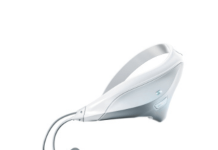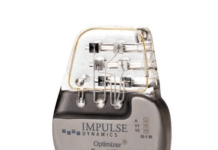Samsara Vision, a company focused on bringing vision and freedom back to patients with late-stage, age-related macular degeneration (AMD) through advanced visual prosthetic devices, announced the completion of the first U.S. surgeries of its SING IMT™ (Smaller-Incision New-Generation Implantable Miniature Telescope), as part of the CONCERTO clinical study, a U.S.-based Food and Drug Administration (FDA) study to evaluate improvements in visual acuity and safety of the device in people living with late-stage AMD. David RP Almeida, MD, MBA, PhD, from Erie Retinal Surgery (PA), and Marc H. Levy, MD, from the Sarasota Retina Institute (FL), performed the first procedures using the SING IMT™ in late June.
“The SING IMT™ procedure represents a potential technological leap forward and the surgery, using the pre-loaded delivery system, allowed for not only a smaller corneal incision, but also a consistent and predictable insertion of the device,” said Dr. Levy.

The CONCERTO trial will recruit 100 adults aged 65 and older living with stable (non-active neovascularization), bilateral central scotomas (blind spots) due to late-stage AMD and fovea-involving geographic atrophy or disciform scar to receive a SING IMT™ in one eye. In addition, candidates cannot have had previous cataract surgery in the study eye and must agree to post-operative comprehensive visual rehabilitation and training.
Dr. Almeida added, “The surgery went well. I’m pleased that the SING IMT™ telescopic micro-optical device allows for ease of insertion and centration. It’s wonderful to see the excitement of eligible phakic patients with severe vision loss and – as these patients adapt and learn to use their new vision during visual rehabilitation – I believe we will see a significant interest and demand for this important intervention.”
“It’s highly encouraging that our first surgeries went smoothly. We look forward to working with the eye health community across the country during the CONCERTO study. Our goal is to bring our new technology to people blinded by late-stage AMD across the United States,” said Thomas Ruggia, Chief Executive Officer at Samsara Vision. “We intend to work closely with the FDA to determine a timely pathway to bring the SING IMT™ to market in the United States.”
SING IMT™
The SING IMT™ is a Galilean-style telescope implant designed to improve visual acuity and quality of life for patients with late-stage AMD. It is implanted during typical, out-patient cataract surgery with a corneal incision range between 6.5 mm to 7.5 mm. Images seen in “straight-ahead” vision are magnified 2.7x and projected onto healthy, undamaged areas of the macula in the back of the eye, reducing the apparent impact of the AMD “blind spot” on central vision.
To learn more about the CONCERTO study, visit www.concertostudy.com.
Unmet Treatment Needs in Age-Related AMD
Age-related macular degeneration (AMD) is a leading cause of permanent vision loss for people age 50 and older, and the number one cause of blindness in people age 65 years and older. As many as 11 million Americans are affected by some form of macular degeneration and this number will increase to 22 million by 2050. Nearly 2 million Americans have advanced forms of AMD with associated vision loss. While treatments exist to try to slow the progression of AMD, and there are assistive devices that can help people with reduced vision see better with magnification or more light, many patients will progress in their disease. There is no cure for late-stage AMD. The SING IMT™ is approved for late-stage AMD patients who are 55 years of age or older in CE Referenced Countries, but it is not currently FDA approved in the United States.
The SING IMT™ is not a cure for late-stage AMD. It will not return vision to the level a patient had before AMD, nor will it completely make up for vision loss. The most common risks of the SING IMT™ surgery include inflammatory deposits or precipitates on the device and increased intraocular pressure. Significant adverse events include corneal edema, vision-impairing corneal edema, corneal transplant, and decrease in visual acuity. There is a risk that having the telescope implantation surgery could worsen your vision rather than improve it. Individual results may vary.
About Samsara Vision
Samsara Vision is a privately held specialty medical device company headquartered in the United States and engaged in the research, development, manufacture, and marketing of proprietary implantable ophthalmic devices and technologies that are intended to significantly improve vision and quality of life for individuals with untreatable retinal disorders. We believe that rejuvenating eyesight revives the spirit, allowing people to reconnect to the things in life that they love to see and do. Our approach includes working collaboratively with health care providers, researchers, payers, and advocates to ensure that people living with deteriorating vision have access to our novel technologies and support paths thereby better ensuring a future where they can see anew. Learn more at https://www.samsaravision.com
Safe Harbor Statement
This press release contains express or implied forward-looking statements pursuant to U.S. Federal securities laws. Forward-looking statements include those about the potential benefits to be derived from the SING IMT™ and the intent to work closely with the FDA to determine a timely pathway to bring the SING IMT™ to market in the United States and the belief that rejuvenating eyesight revives the spirit, allowing people to reconnect to the things in life that they love to see and do. These forward-looking statements and their implications are based on the current expectations of the management of Samsara only, and are subject to a number of factors and uncertainties that could cause actual results to differ materially from those described in the forward-looking statements. The following factors, among others, could cause actual results to differ materially from those described in the forward-looking statements: claims by other companies and persons regarding ownership over intellectual property; changes in technology and market requirements; Samsara may encounter delays or obstacles in launching and/or successfully completing its clinical trials; Samsara’s products may not be approved by regulatory agencies, Samsara’s technology may not be validated as it progresses further and its methods may not be accepted by the scientific community; Samsara may be unable to retain or attract key employees whose knowledge is essential to the development of its products; unforeseen scientific difficulties may develop with Samsara’s process; Samsara’s products may wind up being more expensive than it anticipates; results in the laboratory may not translate to equally good results in real clinical settings; results of preclinical studies may not correlate with the results of human clinical trials; Samsara’s patents may not be sufficient; Samsara’s products may harm recipients; changes in legislation may adversely impact Samsara; inability to timely develop and introduce new technologies, products and applications; the risk factors and uncertainties described in the Registration Statement on Form S-1, as amended (File No. 333-260742) filed with the U.S. Securities and Exchange Commission; loss of market share and pressure on pricing resulting from competition, which could cause the actual results or performance of Samsara to differ materially from those contemplated in such forward-looking statements. Except as otherwise required by law, Samsara undertakes no obligation to publicly release any revisions to these forward-looking statements to reflect events or circumstances after the date hereof or to reflect the occurrence of unanticipated events.






